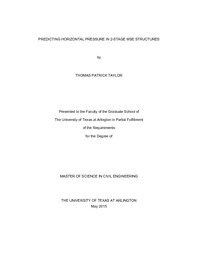
ATTENTION: The works hosted here are being migrated to a new repository that will consolidate resources, improve discoverability, and better show UTA's research impact on the global community. We will update authors as the migration progresses. Please see MavMatrix for more information.
Show simple item record
| dc.contributor.author | Taylor, Thomas Patrick | en_US |
| dc.date.accessioned | 2015-07-31T22:10:00Z | |
| dc.date.available | 2015-07-31T22:10:00Z | |
| dc.date.submitted | January 2015 | en_US |
| dc.identifier.other | DISS-13032 | en_US |
| dc.identifier.uri | http://hdl.handle.net/10106/25010 | |
| dc.description.abstract | Mechanically Stabilized Earth (MSE) structures have been successfully used in the United States as embankment support structures for heavy highway transportation projects since 1972. On project sites that have poor foundations and where large settlements are predicated a variation of MSE called 2-Stage MSE is utilized. As the name suggests, 2-Stage structures are constructed in two stages. Stage-1 consists of constructing a flexible faced MSE structure and Stage-2 consists of attaching a veneer to the face of the Stage-1 structure. The Stage-1 and Stage-2 structures are separated by a short distance forming a cavity that is filled with granular material. The foundation may be improved before construction of the Stage-1 structure. After construction of the Stage-1 structure and before construction of the Stage-2 structure the foundation is allowed to consolidate. The 2-Stage engineering process includes design and analysis of the foundation, the Stage-1 MSE and the Stage-2 Veneer including the connection element. The design of the connection element requires that the horizontal pressure in the cavity between the Stage-1 and Stage-2 structure be determined. There are no published standard specifications that outline how to determine the horizontal pressure in the cavity for 2-Stage MSE structures. Designs of 2-Stage MSE have been known to use the theory of soil arching to predict the horizontal pressure in the cavity. The main objective of this study is to predict the horizontal pressure in the cavity of the 2-Stage structure through numerical modelling. The study will first determine if soil arching is occurring in the cavity by construction of a base-line model of the Stage-1 and Stage-2 structure by assuming each facing are non-yielding rigid structures. The base-line model numerical results will be compared with the classic silo pressure equation. Parametric studies of the base-line model are conducted through varying the internal frictional angle of the cavity material and the interface friction angle of the facing. A final parametric a study is conducted by changing the Stage-1 facing into a yielding structure by prescribing internal settlement in the control model. The parametric study results are compared to the base-line model results to establish the effect the variation of the properties have on the magnitude of the horizontal pressure in the cavity. | en_US |
| dc.description.sponsorship | Puppala, Anand | en_US |
| dc.language.iso | en | en_US |
| dc.publisher | Civil & Environmental Engineering | en_US |
| dc.title | Predicting Horizontal Pressure In 2-stage MSE Structures | en_US |
| dc.type | M.S. | en_US |
| dc.contributor.committeeChair | Puppala, Anand | en_US |
| dc.degree.department | Civil & Environmental Engineering | en_US |
| dc.degree.discipline | Civil & Environmental Engineering | en_US |
| dc.degree.grantor | University of Texas at Arlington | en_US |
| dc.degree.level | masters | en_US |
| dc.degree.name | M.S. | en_US |
Files in this item
- Name:
- Taylor_uta_2502M_13032.pdf
- Size:
- 5.351Mb
- Format:
- PDF
This item appears in the following Collection(s)
Show simple item record


